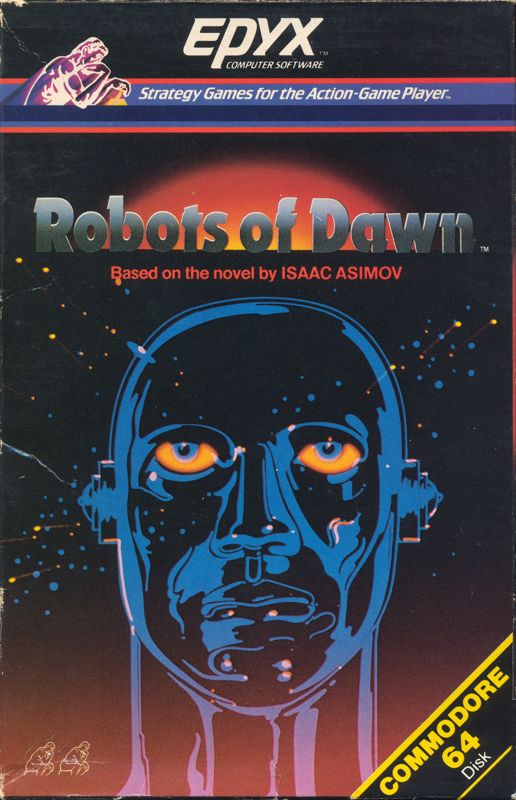Retro Replay Review
Gameplay
Robots of Dawn places you squarely in the polished shoes of Earth detective Elijah Baley, Tasked with unraveling the murder of Dr. Han Fastolfe on the Spacer world of Aurora. Unlike action-heavy titles, this adventure leans into the cerebral side of gaming, requiring you to gather evidence systematically, analyze alibis, and deduce the murderer’s motive, means, and opportunity. Each playthrough offers a fresh twist: the identity of the killer changes, along with the location of key clues and the behavior of suspects, ensuring that no two investigations feel identical.
(HEY YOU!! We hope you enjoy! We try not to run ads. So basically, this is a very expensive hobby running this site. Please consider joining us for updates, forums, and more. Network w/ us to make some cash or friends while retro gaming, and you can win some free retro games for posting. Okay, carry on 👍)
The heart of the gameplay is its interrogation system. Baley’s interactions with high-profile suspects—Dr. Kelden Amadiro, Gladia, Vasilia, and even his trusted companion R. Daneel Olivaw—are fueled by branching dialogue, timed responses, and the careful selection of questions. You’ll need to read each character’s demeanor and body language, noting microexpressions and subtext to pinpoint inconsistencies. Successfully extracting the truth often hinges on your ability to connect disparate clues under the pressure of Aurora’s tense political climate.
Adding another layer of complexity is Baley’s notorious “spacophobia.” His dread of open spaces on Aurora both limits and directs exploration, forcing you to find creative routes through domed cities or secure transport corridors. The game design cleverly weaves Baley’s psychological hurdle into progression, with your choices determining how quickly—or reluctantly—he overcomes each new exposure.
Graphics
As a text-driven adventure, Robots of Dawn does not rely on high-definition visuals or flashy 3D environments. Instead, it delivers crisp, thematic illustrations at key story junctures—portraits of suspects, atmospheric depictions of Aurora’s biodomes, and schematic layouts of Fastolfe’s laboratories. These black-and-white sketches are simple yet evocative, giving life to the science-fiction setting without distracting from the cerebral core of the game.
The user interface complements the narrative-focused experience with a clean, retro-inspired design. Your command window, evidence journal, and dialogue tree are neatly arranged, allowing you to switch between suspect profiles, lab reports, and conversation logs at will. This streamlined layout minimizes confusion and supports rapid back-and-forth investigation, which is crucial when new facts emerge or suspects’ stories shift.
While some modern gamers may yearn for animated cutscenes or voice acting, the minimalist approach here encourages you to fill in the gaps with your imagination—an homage to classic interactive fiction. Subtle ambient sounds—humming machinery, distant rotor blades, muted footsteps—play in the background, enhancing immersion without overshadowing the textual narrative.
Story
Rooted in Isaac Asimov’s renowned novel, the game faithfully adapts The Robots of Dawn’s blueprint: a locked-room murder mystery set against the backdrop of interplanetary politics and the evolving relationship between humans and robots. You’ll navigate Aurora’s rigid social structures and simmering anti-Earth sentiment, peeling back layers of intrigue as you question witnesses whose loyalties are divided by familial ties, scientific ambition, and cultural pride.
The narrative deftly balances the procedural elements of detective work with the philosophical undercurrents that made Asimov famous. Conversations with Dr. Fastolfe’s daughters—Gladia and Vasilia—reveal not just personal motives but also the broader implications of robotic autonomy and Spacer society’s isolationist policies. Even the ever-logical R. Daneel Olivaw becomes a potential suspect, prompting you to examine the laws of robotics and their real-world loopholes.
Variability in the murderer’s identity adds replay value and emotional depth. Each culprit’s reasoning ties directly into Asimov’s themes of duty versus compassion, as well as the clash between human intuition and robotic logic. When you finally present your case to the Chairman of Aurora, the climax feels earned—your deductions reflect both forensic precision and a nuanced understanding of each character’s psyche.
Overall Experience
Robots of Dawn offers a richly layered detective experience that will appeal most to fans of interactive fiction, classic sci-fi, and cerebral puzzles. Its commitment to faithful storytelling, combined with dynamic suspect behaviors and branching outcomes, makes each playthrough feel fresh. The absence of combat or reflex-based challenges keeps the focus squarely on deduction, conversation, and moral deliberation.
While the minimalist visuals and text-driven format may not suit everyone, they perfectly serve the game’s strengths: immersive world-building, thought-provoking dialogue, and methodical investigation. If you cherish stories that reward careful reading, patience, and repeated scrutiny of every clue, you’ll find Robots of Dawn a compelling journey into Asimov’s visionary universe.
In the end, this title stands as a testament to the enduring power of narrative-first game design. It challenges you not with boss fights or quick-time events but with the complexities of human (and robotic) psychology. For players seeking an intelligent, story-driven adventure that honors its literary roots, Robots of Dawn is a must-play.
 Retro Replay Retro Replay gaming reviews, news, emulation, geek stuff and more!
Retro Replay Retro Replay gaming reviews, news, emulation, geek stuff and more!









Reviews
There are no reviews yet.